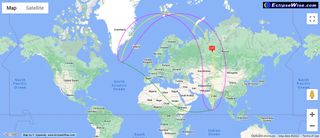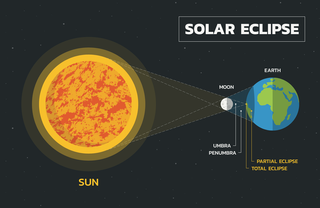Solar eclipse of October 2022: When, where and how to see it on Oct. 25
On Tuesday, Oct. 25, the moon will pass in front of the sun in the last solar eclipse of 2022. Here's everything you need to know.
On Tuesday, Oct. 25, the moon will pass in front of the sun in the last solar eclipse of 2022 in an event that could be visible to millions of skywatchers lucky enough to be in the visibility path.
The Oct. 25 solar eclipse will be a partial solar eclipse and the second eclipse of the sun of 2022. It will be primarily visible from Europe and parts of Africa and Asia, but you'll be able to watch online. Learn all about the last solar eclipse of 2022 by the moon in our guide below.
Related: Solar eclipses 2022: When, where & how to see them
When is the solar eclipse and how to watch online?
The exact time of the Oct. 25 solar eclipse does depend on where you're observing from. The eclipse itself begins in the Atlantic Ocean at 08:58:20 Universal Time (GMT), which would be about 4:58 a.m. EDT. It will end at 9:01 a.m. EDT (1301 GMT). The moment of peak eclipse will occur at 7 a.m. EDT (1100:09 GMT), according to eclipse scientist Fred Espenak.
If you are not in the visibility area, you have several options on how to watch the solar eclipse. Our livestream guide to the Oct. 25 solar eclipse has the full list so far.
TimeandDate.com will have a live webcast that begins at 4:30 a.m. EDT (0830 GMT) and runs through the event. The Ceccano, Italy-based Virtual Telescope Project will have its own webcast beginning at 5 a.m. EDT (0900 GMT) and the Royal Observatory Greenwich will feature live commentary from expert astronomers beginning at 5:05 a.m. EDT (0905 GMT).
If you're looking for particular eclipse start and stop times for your city in the visibility area, this table from Fred Espenak has detailed times for the eclipse.
What will the partial solar eclipse look like?
At its peak, the Oct.25 solar eclipse will block 82% of the sun as the moon and star will not be perfectly aligned with Earth as they are during a total solar eclipse. That means that at its best, only a sliver of the sun should be visible from "the point of central eclipse." This prime viewing spot is at the North Pole, so few if any observers will likely see it.
But for observers across Europe and parts of Africa, the Middle East and Asia, the sun will appear obscured to varying degrees depending on how close an observer is to the central path of the eclipse. In Russia, for example, about 80% of the sun's disk will be covered by the moon, while 70% will appear blocked from western China. Norway and Finland see eclipses 63% and 62%, respectively.
Visibility map for the Oct. 25 solar eclipse

The partial solar eclipse of Oct. 25 will be visible across large parts of Europe, northeast Africa, the Middle East and central Asia. It will include wide areas of the Arctic, including the North Pole, where few observers are likely to see it.
While this eclipse's path will begin in the northern Atlantic Ocean, it does cross encompass most of Europe, and wide swaths of Africa and Asia, where millions of skywatchers could potentially see it, weather permitting.
The webcasts provided above are from viewpoints at various locations in the visibility region, hence their different start times.
Solar eclipse safe viewing tips
WARNING: Looking directly into the sun can lead to blindness and other forms of permanent eye damage if you aren't wearing proper eye protection. Always be sure to use proper equipment when observing the sun or a solar eclipse.
If you're planning to watch the Oct. 25 solar eclipse, or any other sun event, you'll need to make sure you have the right equipment. Observers should use special protective eyewear or certified eclipse glasses, but here is an important note: REGULAR SUNGLASSES WILL NOT PROTECT YOU, EVEN WITH UV PROTECTION.
Our guide on how to observe the sun safely has more tips on what gear you need and what to look for.

— How to safely observe the sun
— Turn your cereal box into an eclipse projector
— Make a safe sun projector with binoculars
You want to look for eclipse glasses that are ISO-certified, which means they've been approved by the International Organization for Standardization as safe for solar observing. That means they've been tested so that they do not let any more than 0.00032% of the sun's light through their light filters, are free of defects like scratches or bubbles, can cover both eyes, and list the name of their manufactures and instructions for proper use.
The safest way to observe a solar eclipse is to use indirect methods, like building a pinhole camera to project the eclipse on an external surface. You can use our guide on how to build a pinhole camera to get started.
If you're using a camera, companies like Celestron make special camera filters you can use for your smartphone or DSLR camera. NASA advises observers to use extreme caution during solar eclipse events. For partial eclipses, keep the glasses on at all times. For total eclipses, NASA has a guide for when to take off the glasses.
Why do solar eclipses occur?

Solar eclipses occur when the moon appears to pass in front of the sun when viewed from Earth. They can only occur when the phase of the moon is in its "new moon" stage, since that's when the moon is between the Earth and sun. However, the moon's orbit around Earth is tilted about 5 degrees with respect to the sun, so the two do not align every new moon, which is why there is not a solar eclipse every month.
In a bit of cosmic coincidence, the sun is 400 times bigger than Earth's moon, but the moon orbits the Earth at a range that is 400 times closer than the sun. When the moon lines up perfectly with the sun, when viewed from Earth, it completely blocks the sun in a total solar eclipse. These happen every 18 months or so.
There are times, however, when the moon appears to cross in front of the sun but not block the star completely. This is when we get partial solar eclipses. Sometimes, the moon is slightly too far from Earth to fully block the sun, creating a dazzling "ring of fire" effect in what is known as an annular solar eclipse.
When is the next solar eclipse?

After the Oct. 25 partial solar eclipse, we'll have to wait until 2023 for the next time the moon will cross in front of the sun. There are two solar eclipses in 2023.
The next immediate solar eclipse will occur on April 20, 2023 and will be a so-called hybrid solar eclipse. This is an eclipse that can look like an annular eclipse, also known as a ring of fire solar eclipse, from some parts of its track and a total solar eclipse from others. This eclipse will be visible from parts of southeast Asia, the East Indies, Australia, the Phillipines and New Zealand, Indonesia and Papua New Guinea.
After the April 20 solar eclipse, there will be an annular solar eclipse on Oct. 14, 2023. This eclipse will be visible across parts of North America, Central America and South America, with the "ring of fire" effect visible from the western United States, Central America, Columbia and Brazil.
If you can't wait that long, there will also be a total lunar eclipse on Nov. 8, 2022.
Bibliography
Partial Solar Eclipse of 2022 Oct 25, Fred Espenak, EclipseWise.com, Retrieved October 22, 2022 from https://eclipsewise.com/solar/SEprime/2001-2100/SE2022Oct25Pprime.html.
Google Eclipse Map Page, Partial Solar Eclipse of 2022 Oct 25, Fred Espenak, EclipseWise.com. Retrieved October 22, 2022 from https://eclipsewise.com/solar/SEgmapx/2001-2100/SE2022Oct25Pgmapx.html.
The Ultimate Guide to Observing the Sun. Celestron. Retrieved October 22, 2022 from https://www.celestron.com/blogs/knowledgebase/the-ultimate-guide-to- observing-the-sun
Solar Eclipse Glasses: Where to Buy the Best, High-Quality Eyewear, Retrieved October 22, 2022 from https://www.space.com/36941-solar-eclipse-eye-protection-guide.html.
Partial Solar Eclipse - October 25, 2022, TimeandDate.com, Retrieved October 22, 2022 from https://www.youtube.com/watch?v=0sx_vuKEGlY.
Solar Eclipse LIVE | 25 October 2022, Royal Observatory Greenwich, Retrieved October 22, 2022 from https://www.youtube.com/watch?v=2FKh2xLo4Ek.
Editor's Note: If you get a good photo of the partial solar eclipse and would like to share it with Space.com's readers, send your photo(s), comments, and your name and location to spacephotos@space.com.
Email Tariq Malik at tmalik@space.com or follow him @tariqjmalik. Follow us @Spacedotcom, Facebook and Instagram.
Join our Space Forums to keep talking space on the latest missions, night sky and more! And if you have a news tip, correction or comment, let us know at: community@space.com.
Get the Space.com Newsletter
Breaking space news, the latest updates on rocket launches, skywatching events and more!

Tariq is the Editor-in-Chief of Space.com and joined the team in 2001, first as an intern and staff writer, and later as an editor. He covers human spaceflight, exploration and space science, as well as skywatching and entertainment. He became Space.com's Managing Editor in 2009 and Editor-in-Chief in 2019. Before joining Space.com, Tariq was a staff reporter for The Los Angeles Times covering education and city beats in La Habra, Fullerton and Huntington Beach. In October 2022, Tariq received the Harry Kolcum Award for excellence in space reporting from the National Space Club Florida Committee. He is also an Eagle Scout (yes, he has the Space Exploration merit badge) and went to Space Camp four times as a kid and a fifth time as an adult. He has journalism degrees from the University of Southern California and New York University. You can find Tariq at Space.com and as the co-host to the This Week In Space podcast with space historian Rod Pyle on the TWiT network. To see his latest project, you can follow Tariq on Twitter @tariqjmalik.
